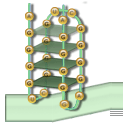 |
Ramapo College Bioinformatics Group GRSDB - The 'G'-Rich Sequences Database |
| Search Help | Glossary of terms | Understanding G-Scores | Dealing with overlaps |
Computing G-Scores
A scoring method is applied to each QGRS. The computed score, called a G-score (1), rewards sequences with larger G-groups (2 G's per groups is a minimum), smaller gaps and more even gaps between the G-groups. The properties of the scoring system can be seen from the table below, adapted from the ACPT gene in GRSDB. In this table, the groups of G's making up the G-quadruplex are shown in bold.
Some comments on this example.
Sample QGRS in Exons of Product 1 of gene ACPT
Exon Number |
QGRS Position |
Distance from 3' or 5' ss |
QGRS |
G-Score |
1 |
1325 |
3:2 |
GGCCGGCCTGGGG |
0.83333 |
1 |
1546 |
5:60 |
GGACCCACACAAGGAGGTGG |
0.50000 |
4 |
3067 |
5:12 |
GGAGGG CTGG ACGG |
1.00000 |
10 |
6034 |
3:83 |
GGG TGCCTGCGGG CCTTGGGGGG |
1.81219 |
This choice of scoring system is in agreement with the existing literature on loop structures in G-quadruplexes. In particular, the data gathered in this research points to loop sizes tending to be small and preferentially equal or nearly equal.
1.D'Antonio,L. and Bagga,P.S. (2004) Computational methods for predicting intramolecular G-quadruplexes in nucleotide sequences. Computational Systems Bioinformatics, CSB 2004. Proceedings . 2004 IEEE, Pages:561-562.
| Search Help | Glossary of terms | Understanding G-Scores | Dealing with overlaps |